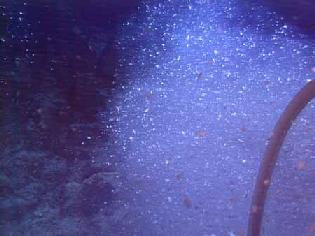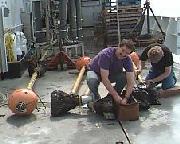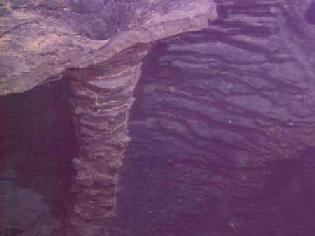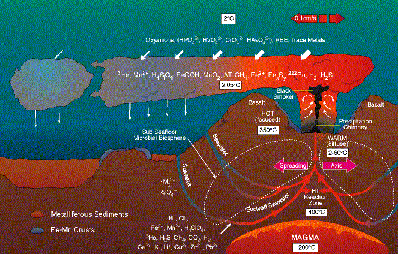WHAT'S NEW:
BACKGROUND:
Mission
Project Description
Cruise Plans:
Participants
Technology (ROV, ships, etc.)
Future Plans
Results:
1998 NeMO Cruise
Axial 1998 "Eruption"
Logbook
June 27, 1999
June 27, 1999
Contents:
- News from Thompson
- News from Wecoma
- Participant Perspective
- Logbook from Teacher at Sea
- Question/Answer from shore to sea
Thompson Science Report
Chief Scientist's Weekly Report 6-27
 This
has been a great day out here at Axial Volcano. Were just now recovering
the ROPOS after working 19 hours on the bottom. During this dive,
we were able to accomplish much of the sampling we have strived to do
over the last few days. Between the new and improved Vent
Fluid Sampler and the Suction
sampler, more than 30 vent fluid and biological samples were taken
at several locations. These samples will provide critical material for
analysis for most of the investigators on board and is probably a record
for samples taken during a single dive. We also learned a lot about the
"state" of the system. Most of the venting is now concentrated around
the Marker 33 and Cloud Vent (photo
above) sites, which may have elevated heat fluxes relative to last year.
In fact, we only found one significant vent at the northern end of the
system, although it was a very interesting one. This vent, which was in
the vicinity of a series of vents characterized by their milky color last
year ( Milky,
Magnesia etc.), was now emitting a steady cloud of large white flocs
(photo right and calendar photo of the day) which covered the surrounding
rocks with a blanket of "snow" and brought to mind one of those "Christmas
scenes in a glass" after theyve been shaken up. What we are probably
witnessing at this site is the late stage of a subsurface microbial community
that is producing large quantities of sulfurous material which they make
from metabolizing the dissolved hydrogen sulfide in the fluids. This material
is produced in sufficient quantity and rapidly enough to produce a steady
stream of this material. This probably requires a special balance of a
high hydrogen sulfide concentration, availability of subsurface cavities,
and a relatively slow amount of flow into the cavity.
This
has been a great day out here at Axial Volcano. Were just now recovering
the ROPOS after working 19 hours on the bottom. During this dive,
we were able to accomplish much of the sampling we have strived to do
over the last few days. Between the new and improved Vent
Fluid Sampler and the Suction
sampler, more than 30 vent fluid and biological samples were taken
at several locations. These samples will provide critical material for
analysis for most of the investigators on board and is probably a record
for samples taken during a single dive. We also learned a lot about the
"state" of the system. Most of the venting is now concentrated around
the Marker 33 and Cloud Vent (photo
above) sites, which may have elevated heat fluxes relative to last year.
In fact, we only found one significant vent at the northern end of the
system, although it was a very interesting one. This vent, which was in
the vicinity of a series of vents characterized by their milky color last
year ( Milky,
Magnesia etc.), was now emitting a steady cloud of large white flocs
(photo right and calendar photo of the day) which covered the surrounding
rocks with a blanket of "snow" and brought to mind one of those "Christmas
scenes in a glass" after theyve been shaken up. What we are probably
witnessing at this site is the late stage of a subsurface microbial community
that is producing large quantities of sulfurous material which they make
from metabolizing the dissolved hydrogen sulfide in the fluids. This material
is produced in sufficient quantity and rapidly enough to produce a steady
stream of this material. This probably requires a special balance of a
high hydrogen sulfide concentration, availability of subsurface cavities,
and a relatively slow amount of flow into the cavity.
We were heading back to the Marker 33 site to recover the rest of the instruments (into the elevator) when the ROPOS team determined that the vehicle had to return to the surface for maintenance. It certainly served the scientists well today.
News from the microbiology lab on board was very intriguing and potentially very exciting. Some of the cultures made from samples taken at Marker 33 continued to grow at temperatures in excess of 90 Centigrade, which is very unusual. We await further word on this from microbiologists Julie Huber and Sheryl Bolton.
We hope to begin a very ambitious dive early in the morning that will likely last through most of the day.
Wecoma Science Report
See Wecoma's teacher log for information.
Listing of all Science News postings
Life at Sea: Participant Perspective
Bill Chadwick
NOAA Vents Program/Oregon State University
 My name is Bill Chadwick.
For the past decade, I've been studying submarine volcanic eruptions on
the Juan
de Fuca and Gorda Ridges with the NOAA/Vents
Program, through Oregon State University.
I'm a volcanologist - someone who studies active volcanoes. The last 10
years has been a great time to study deep ocean eruptions because we have
only had the
technology to detect such eruptions within that short time. Before
that, we had no way of knowing when an eruption might be occuring on the
mid-ocean ridge system, even though 75% of the Earth's volcanism occurs
there, but now submarine eruptions can be detected routinely in the NE
Pacific. This has been a very exciting development and has allowed us
to learn a lot about them in a short period of time.
My name is Bill Chadwick.
For the past decade, I've been studying submarine volcanic eruptions on
the Juan
de Fuca and Gorda Ridges with the NOAA/Vents
Program, through Oregon State University.
I'm a volcanologist - someone who studies active volcanoes. The last 10
years has been a great time to study deep ocean eruptions because we have
only had the
technology to detect such eruptions within that short time. Before
that, we had no way of knowing when an eruption might be occuring on the
mid-ocean ridge system, even though 75% of the Earth's volcanism occurs
there, but now submarine eruptions can be detected routinely in the NE
Pacific. This has been a very exciting development and has allowed us
to learn a lot about them in a short period of time.
So obviously one of my primary interests here at Axial Volcano is learning about the character of the 1998 eruption, the lava flow it produced, and about the behavior of Axial volcano in general. For example, some of the questions I'm trying to answer include: how much lava came out? over what area? how fast did it come out? how do the lava morphologies we see give clues to how the eruption evolved through time? how is this eruption similar or different from other submarine eruptions we've studied? For a lot of these questions we have partial answers from our NeMO research cruise last year, and we hope to find more answers this summer.
Our primary tool is the video of ROPOS - going down to the bottom and looking
around. We make geologic
transects so that we can map out the location and extent of the new lava.
Navigation of ROPOS on the bottom is critical to this sort of effort -
you have to know where you are at all times to make any sense out of your
observations - so ROPOS navigation
is one of the areas I oversee. We also use the scanning
sonar on ROPOS to collect high-resolution
bathymetry of the eruption site. This bathymetry allows us to make
maps that show details of the eruption site over a much larger area than
you can view with ROPOS's video camera. Such maps show us many features
of the eruption site that would be hard to discern otherwise, and we plan
to collect more of this data this year. I'm also working with some innovative
seafloor instruments called  acoustic
extensometers that are designed to measure distances very precisely
between points on the ocean floor. These distance measurements can detect
deformation of the volcano caused by movements of magma underground and
is one of the standard methods used to monitor active volcanoes on land.
Some of our extensometers (photo left) were in place on Axial's north
rift zone when the 1998 occurred, and we recovered them last year. It
turns out they measured a distance change of 4 centimeters at the time
of the eruption, from which we can estimate the depth to the magma
reservoir beneath Axial's summit caldera and calculate how much magma
was removed from it during the eruption. We redeployed the instruments
on the north rift zone last summer where they have been recording data
since then, and we plan to recover and redeploy them again this year.
acoustic
extensometers that are designed to measure distances very precisely
between points on the ocean floor. These distance measurements can detect
deformation of the volcano caused by movements of magma underground and
is one of the standard methods used to monitor active volcanoes on land.
Some of our extensometers (photo left) were in place on Axial's north
rift zone when the 1998 occurred, and we recovered them last year. It
turns out they measured a distance change of 4 centimeters at the time
of the eruption, from which we can estimate the depth to the magma
reservoir beneath Axial's summit caldera and calculate how much magma
was removed from it during the eruption. We redeployed the instruments
on the north rift zone last summer where they have been recording data
since then, and we plan to recover and redeploy them again this year.
Trying to study volcanoes on the bottom of the ocean is challenging work - you can't just walk around on them or drive on them or look out your window to see what's going on like you can at volcanoes on land. But on the other hand, since they are harder to observe and we know so much less about them, it makes every discovery seem significant and new. That's a feeling scientist like to have. It makes it fun.
Finally, I'd like to say hi to my wife Teresa and my daughter Kelly, who are helping each other manage while dad is away from home at sea. Kelly is 6 years old and is currently fascinated with the meaning of the word "infinity". She has been telling me lately "I love you, daddy, infinity!" Well, I would like to tell them both that I miss them, infinity!!
Listing of all Perspectives postings
Teacher At Sea Logbook
Wecoma Teacher at Sea Log Day 12, 6/27/99
Following lunch the CTD was deployed. The CTD has been a valuable member of the scientific cruise collecting data on conductivity, temperature and depth. Other instruments are occassionally added to elicit additional data and information from our sawtooth tows.
Dr Richard Feely has added an insitu pump to the instrument's ability to collect particles in the water column. This instrument filters sea water at depth in the natural environment before chemical transformation can occur. The pump allows the scientists to collect samples throughout the year and measure changes in composition over time. It is like having a laboratory in the ocean depths. Dr. Feely would like to add this insitu pump to the moorings that hold the MAPR (Miniature Autonomous Plume Recorder). A signal could then be transmitted to the pump to collect seawater, filter the water at depth and then relay data to the laboratory on land. The scientists would like this technique to be added to the data collection process at Axial Volcano.
It is amazing to me how extensive the data collection has been over the last two weeks. We have acquired a vast amount of information that will take scientists months to interpret and place into understandable charts, graphs and written reports.
Rachel Shackelford and Don McGee, University of Hawaii research team, have begun to pack away their portion of the laboratory. It is beginning to look like Christmas with large boxes and crates taped and stacked.
Dr. Ed Baker, chief scientist NOAA/PMEL, has worked with all scientists aboard to ensure that everyone has collected everything they need from the Cleft Segment. The last tows and cast will be collected tonight.
When I awake tomorrow morning the Wecoma will be moving towards its homeport, Newport, Oregon. We'll make port in 22 hours.
Check with me tomorrow to see what our cruise home will bring.
Fair seas,
Ms. Deck
Teacher Log #7 6/27/99
What a great day of science! Today you could barely feel the ship move it was so calm out here. No one noticed though, because ROPOS was in the water busy doing what it does best - scientific exploration under the sea. All systems and equipment worked nearly flawless during the 20 hours ROPOS was in the water. It went in the water at 11:00 pm on Saturday night and is just now (7:20 pm Sunday night) being brought back on deck.
When I arrived in the ROPOS lab this morning for my four hour watch as a frame
grabber (collecting single frame pictures of what were seeing on the video
monitors), the first views of the ocean floor in Axial caldera were of
fabulous lava flows. Though bottom visibility is limited to the
range of the lights, it still provided an excellent perspective of how
the flow of hot lava occurred. Standing by in the lab observing the  goings on, geologists talked freely about the types of flows and the possible
explanations for the unusual formations. Such names as "sheet",
"lobate" and "pillow" flows were used. Sheet flows were the most
abundant lava form at this site due to the higher eruption rate. Lobate
and pillow lava flows are formed during lower eruption rate, which allows
the seawater to cool and harden the lava faster. This keeps the size
of the formation smaller and produces the more rounded form. My favorite
structures were the "roofs" and "arches" being supported by pillars (photo
left) of lava. When sheet lava flows, the surface may harden but the inner
region is still liquid. The inner liquid region breaks out from below
and continues to spread. As the lava moves out from below, the hardened
surface above may or may not collapse. This is how roof structures are
made. One structure I saw today showed a pillar rising up into a roof
formation that also had a hole right in the center where the pillar and
roof connected (see photo). Water trapped below the flow rose through
this area, slowly creating the pillar and the exit point as one flow after
another laid another layer on the roof. The hole in the roof represents
the inner tube of the pillar where water escaped. Absolutely fabulous
stuff! Take a look in a good geology or earth science book and see what
scientists say about the formations Ive mentioned.
goings on, geologists talked freely about the types of flows and the possible
explanations for the unusual formations. Such names as "sheet",
"lobate" and "pillow" flows were used. Sheet flows were the most
abundant lava form at this site due to the higher eruption rate. Lobate
and pillow lava flows are formed during lower eruption rate, which allows
the seawater to cool and harden the lava faster. This keeps the size
of the formation smaller and produces the more rounded form. My favorite
structures were the "roofs" and "arches" being supported by pillars (photo
left) of lava. When sheet lava flows, the surface may harden but the inner
region is still liquid. The inner liquid region breaks out from below
and continues to spread. As the lava moves out from below, the hardened
surface above may or may not collapse. This is how roof structures are
made. One structure I saw today showed a pillar rising up into a roof
formation that also had a hole right in the center where the pillar and
roof connected (see photo). Water trapped below the flow rose through
this area, slowly creating the pillar and the exit point as one flow after
another laid another layer on the roof. The hole in the roof represents
the inner tube of the pillar where water escaped. Absolutely fabulous
stuff! Take a look in a good geology or earth science book and see what
scientists say about the formations Ive mentioned.
The journey of ROPOS today took us north as we followed the upper south
rift zone of Axial up into an active vent field studied during the
1998 cruise. Many
of the sites showed much less activity or were no longer active at all.
We often talk about life and death in biological terms. What death or
dying is referring to in terms of a vent is the lack of venting due to
the cooling of the magma below the surface. Axial Volcano is a known "Hot
Spot" that happens to sit right in a spreading center known as the Juan
de Fuca ridge. Below this volcano, sits a chamber of magma that powers
the venting that is observed here. Venting is the flow
 of fluid (some hotter then others) out of the cracks in the rock that
has formed above it. Sea water is drawn in through the more porous substrate
and cracks in the rocks. Water is heated as it gets closer to the magma
chamber or heat source. Chemical reactions (diagram right, click
for full size) take place in this extremely hot region below the substrate
and that is what makes vent fluid so special to these scientist. The eruption
of 1998 that was studied in great detail last year is maybe showing
its last effects on this area to the north closest to the region of the
rift where it is believed the eruption centered from. A rift is a spreading
center not a specific point. Eruptions along a rift are often a "diking"
process, where along the rift (crack in the ridge) magma pushes upward
over a long narrow region. This forces both sides of the ridge (separate
plates) to separate and grow. This is the basis of sea floor spreading.
South of this point, starting at Marker
#33, which is still very active, scientists are hoping to see continued
activity this year and in the future. This is the aim
of the NeMO project. To observe over a long-term continual basis the
evolution (life and death) of an active volcanic site. If you have a good
oceanographic map which shows the mid ocean ridge system get it out and
look us up, coordinates are given on this web site. Ill be talking more
about its geology and history in future reports.
of fluid (some hotter then others) out of the cracks in the rock that
has formed above it. Sea water is drawn in through the more porous substrate
and cracks in the rocks. Water is heated as it gets closer to the magma
chamber or heat source. Chemical reactions (diagram right, click
for full size) take place in this extremely hot region below the substrate
and that is what makes vent fluid so special to these scientist. The eruption
of 1998 that was studied in great detail last year is maybe showing
its last effects on this area to the north closest to the region of the
rift where it is believed the eruption centered from. A rift is a spreading
center not a specific point. Eruptions along a rift are often a "diking"
process, where along the rift (crack in the ridge) magma pushes upward
over a long narrow region. This forces both sides of the ridge (separate
plates) to separate and grow. This is the basis of sea floor spreading.
South of this point, starting at Marker
#33, which is still very active, scientists are hoping to see continued
activity this year and in the future. This is the aim
of the NeMO project. To observe over a long-term continual basis the
evolution (life and death) of an active volcanic site. If you have a good
oceanographic map which shows the mid ocean ridge system get it out and
look us up, coordinates are given on this web site. Ill be talking more
about its geology and history in future reports.
In completing todays report, I wanted to mention a few things. First we had a change in luck today, and it may not be just a coincidence. The plastic honey bear that some of us were convinced was causing all our bad luck, was placed in the ROPOS slurp sampler flush bottle ("operation flush"), so that the deep ocean would crush its "bad mojo". Hey, ROPOS just finish a rigorous 19 hour dive. So whatever works, lets stay with it. Second item is the nature of the people in the ROPOS lab at the dives beginning, during and as the hours extend beyond human limits. Words such as excitement, intensity, discovery and even giddy and punchy come to mind. It is a great atmosphere to be part of.
Lastly, yesterdays report proposed a question to you young chemists and physicists.
What equation would you use to calculate the amount of gas given a known volume at a given temperature and pressure?
Well the correct answer is : PV = nRT
where P represents the pressure, V is the volume and T is temperature. R
is a gas constant (with a value of about .0821 L Atm/Mol deg C) and you
solve for "n".
You end up with: n = PV / RT.
Bye for now.
Logbook of all Teacher At Sea postings
Questions & Answers
(oar.pmel.vents.webmaster@noaa.gov)